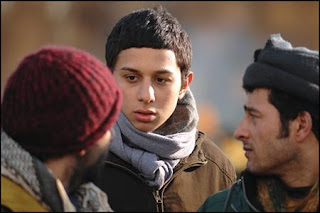
The Skin I Live In
Original title: La Piel Que Habito
Directed by Pedro Almodóvar
Spain, 2011
“The Skin I Live in” reunites Almodóvar with the first star that he launched – Antonio Banderas. The films Almodóvar and Banderas made together in the 1980s – “Labyrinth of Passion”, “Matador”, “Law of Desire”, “Women on the Verge of a Nervous Breakdown” and “Tie Me Up! Tie Me Down!" – formed one of the most iconic onscreen collaboration. Hollywood has truly wasted Banderas's potential. Now, twenty-one years after the 1990's “Tie Me Up! Tie Me Down!” they are back together with a loose adaptation of Thierry Jonquet’s novel ‘Mygale’ (published in English as Tarantula) - the story of diabolical plastic surgeon, whose skills allow him to take control of the people's life in ways unimaginable to anyone but him. The bones of the film's character might be based on the novel, but the rest is all Almodóvar.

“The Skin I Live In” is a story of revenge. Dr Robert Ledgard (Banderas), an eminent plastic surgeon and grief-stricken widower is engaged in an ethically dubious experiment to create a new artificial skin, which he believes, could have saved his wife life. She committed suicide after being horrifically burned in a road accident. Ever since this tragic event Robert becomes obsessed in his search for medical perfection of the idea he developed: heat- and pain-resistant, although still sensitive to the touch, transgenic skin.

In addition to years of study and experimentation, Robert needed three things: no scruples, an accomplice and a human guinea pig. Scruples were never a problem. Marilia (Marisa Paredes, another Almodóvar regular), the woman who looked after him from the day he was born, for reasons known only to her, is his most faithful accomplice. And as for the human guinea pig there's Vera (Sex And Lucia 's Elena Anaya), whom he holds captive in his vast, seemingly inescapable isolated mansion El Cigarral.

The less said about the story, the better. Almodovar cleverly uses flashback to unsettlingly reveal who Vera really is, an outrageous, sexually perverse twist that only he could get away with. Almodóvar’s vision is more ominous than anything I've seen before. The subject is extreme, and the plot so grotesque yet, Almodovar is Almodovar - he has the ability to turn highly disturbing plots into something beautiful. He is constantly testing the limits of plausibility – looked at objectively, the plot appears absurd – but his meticulous craftsmanship and confident storytelling ensures it remains riveting. With “The Skin I Live In” once again he revealed his genius for turning the ridiculous into the sublime.

Dr Ledgard is possibly the director’s most sinister character, but his lunacy is rooted in a domestic tragedy which is instantly humanising. I was never quite sure whether Robert is the mad scientist-style psychopath or a tragic hero. His personal life was already messy when he finds himself falling unexpectedly in love with his most beautiful, and certainly the most unusual, patient. Frankenstein is seduced by his own beautiful monster. Elena Anaya, re-teaming with Almodóvar after a small part in 2002’s “Talk To Her”, is fantastic as the object of Dr Ledgard obsessions. Most of the time totally covered by a flesh-coloured bodysuit that clings to her like a second skin, she spends her life locked up in a room in Robert 's idyllic Toledo mansion, a tastefully-designed deluxe prison.

For anyone who's familiar with Almodóvar's body of work, it is clear that while often appearing frivolous, he explores profound emotional and intellectual matters. He loves self-referencing. Same pieces. Different puzzle. In '”The Skin I Live In” Almodóvar, once again, is playing with themes of power, identity and sexuality. Skin is the frontier that separates us from others, it determines the race to which we belong, it reflects our roots, whether biological or geographical. Although Vera decided that “she has to learn to live within her skin”, even if it is a skin imposed by Dr. Robert, she hasn’t lost her identity. Yet, skin is what appears to define us and, our identity is being shaped by the skin we live in and gaze upon in the mirror. Indeed, a crucial scene sees Robert's wife mortified by looking at what has happened to her face after the accident.

“The Skin I Live In” is beautifully put together. Visuals are stunning, as expected. I can't think of any other director who uses colour as well as Almodovar. Endowed with an extraordinary voice Spanish singer Concha Buika is getting the exposure that she so deserves in the scene as potent as Caetano Veloso singing in “Talk To Her.”

This is a thrilling, edgy, riveting and superbly realised piece of work. Fantastically twisted and provocative story that leaves you wondering who’s heroic, villainous, an oppressor or a victim. Bloody excellent movie. Almodovar at his best.






















































